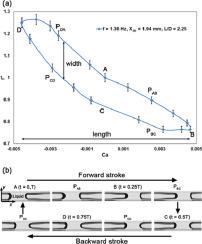当前位置:
X-MOL 学术
›
Int. J. Multiphase Flow
›
论文详情
Our official English website, www.x-mol.net, welcomes your feedback! (Note: you will need to create a separate account there.)
Hydrodynamics of a Completely Wetting Isolated Liquid Plug Oscillating inside a Square Capillary Tube
International Journal of Multiphase Flow ( IF 3.8 ) Pub Date : 2021-02-01 , DOI: 10.1016/j.ijmultiphaseflow.2020.103534 Vyas Srinivasan , Asmita M. Rahatgaonkar , Sameer Khandekar
International Journal of Multiphase Flow ( IF 3.8 ) Pub Date : 2021-02-01 , DOI: 10.1016/j.ijmultiphaseflow.2020.103534 Vyas Srinivasan , Asmita M. Rahatgaonkar , Sameer Khandekar

|
Abstract The effect of imposed flow oscillations on the local hydrodynamics of a completely wetting isolated liquid plug (of silicone oil) placed inside a horizontal square glass capillary tube (1 mm × 1 mm) is studied. A known volume of liquid (plug with a given L/D ratio) is made to harmonically oscillate inside the capillary tube by the action of air pressure on one of its menisci, while the other meniscus interacts freely with the atmosphere. The effect of plug length, imposed oscillation frequency and amplitude, on the net pressure drop and menisci shapes in terms of normalized radii of curvature, is addressed. A hydrodynamic model, based on Bretherton's theory, coupled with Tanner's law is reviewed and simplified for oscillatory flows, which shows excellent correlation with the experimental data, via a single universal fitting parameter. This parameter manifests the combined effect of wall shear stress and additional dissipation due to the dynamically deforming menisci. During oscillations of the liquid plug, the contact lines of both menisci stay pinned and the plug slides over a thin film, exhibiting dynamic hysteresis at both the respective menisci. The system parameter that governs the hydrodynamic of oscillating liquid plug is the instantaneous capillary number, which depends on both, the imposed frequency and amplitude, the former having an overbearing effect on the dynamic menisci shapes. The study clearly brings forward the fact that capillary induced dissipation at the menisci is much more prominent than the wall induced shear.
中文翻译:

在方形毛细管内振荡的完全润湿隔离液塞的流体动力学
摘要 研究了施加的流动振荡对放置在水平方形玻璃毛细管(1 mm × 1 mm)内的完全润湿的隔离液体塞(硅油)的局部流体动力学的影响。已知体积的液体(具有给定 L/D 比的塞子)通过空气压力作用在毛细管中的一个弯液面上而在毛细管内和谐振荡,而另一个弯液面则与大气自由相互作用。在归一化曲率半径方面解决了塞子长度、施加的振荡频率和振幅对净压降和弯液面形状的影响。基于 Bretherton 理论并结合 Tanner 定律的流体动力学模型对振荡流进行了审查和简化,该模型与实验数据显示出极好的相关性,通过单个通用拟合参数。由于动态变形的弯液面,该参数体现了壁面剪应力和额外耗散的综合影响。在液体塞的振荡过程中,两个半月板的接触线保持固定,塞子在薄膜上滑动,在各自的半月板处表现出动态滞后。控制振荡液塞流体动力学的系统参数是瞬时毛细管数,它取决于施加的频率和振幅,前者对动态弯月面形状有很大的影响。该研究清楚地提出了一个事实,即半月板处的毛细管引起的耗散比壁引起的剪切更为突出。由于动态变形的弯液面,该参数体现了壁面剪应力和额外耗散的综合影响。在液体塞的振荡过程中,两个半月板的接触线保持固定,塞子在薄膜上滑动,在各自的半月板处表现出动态滞后。控制振荡液塞流体动力学的系统参数是瞬时毛细管数,它取决于施加的频率和振幅,前者对动态弯月面形状有很大的影响。该研究清楚地提出了一个事实,即半月板处的毛细管引起的耗散比壁引起的剪切更为突出。由于动态变形的弯液面,该参数体现了壁面剪应力和额外耗散的综合影响。在液体塞的振荡过程中,两个半月板的接触线保持固定,塞子在薄膜上滑动,在各自的半月板处表现出动态滞后。控制振荡液塞流体动力学的系统参数是瞬时毛细管数,它取决于施加的频率和振幅,前者对动态弯月面形状有很大的影响。该研究清楚地提出了一个事实,即半月板处的毛细管引起的耗散比壁引起的剪切更为突出。两个半月板的接触线保持固定,插头在薄膜上滑动,在各自的半月板处表现出动态滞后。控制振荡液塞流体动力学的系统参数是瞬时毛细管数,它取决于施加的频率和振幅,前者对动态弯月面形状有很大的影响。该研究清楚地提出了一个事实,即半月板处的毛细管引起的耗散比壁引起的剪切更为突出。两个半月板的接触线保持固定,插头在薄膜上滑动,在各自的半月板处表现出动态滞后。控制振荡液塞流体动力学的系统参数是瞬时毛细管数,它取决于施加的频率和振幅,前者对动态弯月面形状有很大的影响。该研究清楚地提出了一个事实,即半月板处的毛细管引起的耗散比壁引起的剪切更为突出。
更新日期:2021-02-01
中文翻译:

在方形毛细管内振荡的完全润湿隔离液塞的流体动力学
摘要 研究了施加的流动振荡对放置在水平方形玻璃毛细管(1 mm × 1 mm)内的完全润湿的隔离液体塞(硅油)的局部流体动力学的影响。已知体积的液体(具有给定 L/D 比的塞子)通过空气压力作用在毛细管中的一个弯液面上而在毛细管内和谐振荡,而另一个弯液面则与大气自由相互作用。在归一化曲率半径方面解决了塞子长度、施加的振荡频率和振幅对净压降和弯液面形状的影响。基于 Bretherton 理论并结合 Tanner 定律的流体动力学模型对振荡流进行了审查和简化,该模型与实验数据显示出极好的相关性,通过单个通用拟合参数。由于动态变形的弯液面,该参数体现了壁面剪应力和额外耗散的综合影响。在液体塞的振荡过程中,两个半月板的接触线保持固定,塞子在薄膜上滑动,在各自的半月板处表现出动态滞后。控制振荡液塞流体动力学的系统参数是瞬时毛细管数,它取决于施加的频率和振幅,前者对动态弯月面形状有很大的影响。该研究清楚地提出了一个事实,即半月板处的毛细管引起的耗散比壁引起的剪切更为突出。由于动态变形的弯液面,该参数体现了壁面剪应力和额外耗散的综合影响。在液体塞的振荡过程中,两个半月板的接触线保持固定,塞子在薄膜上滑动,在各自的半月板处表现出动态滞后。控制振荡液塞流体动力学的系统参数是瞬时毛细管数,它取决于施加的频率和振幅,前者对动态弯月面形状有很大的影响。该研究清楚地提出了一个事实,即半月板处的毛细管引起的耗散比壁引起的剪切更为突出。由于动态变形的弯液面,该参数体现了壁面剪应力和额外耗散的综合影响。在液体塞的振荡过程中,两个半月板的接触线保持固定,塞子在薄膜上滑动,在各自的半月板处表现出动态滞后。控制振荡液塞流体动力学的系统参数是瞬时毛细管数,它取决于施加的频率和振幅,前者对动态弯月面形状有很大的影响。该研究清楚地提出了一个事实,即半月板处的毛细管引起的耗散比壁引起的剪切更为突出。两个半月板的接触线保持固定,插头在薄膜上滑动,在各自的半月板处表现出动态滞后。控制振荡液塞流体动力学的系统参数是瞬时毛细管数,它取决于施加的频率和振幅,前者对动态弯月面形状有很大的影响。该研究清楚地提出了一个事实,即半月板处的毛细管引起的耗散比壁引起的剪切更为突出。两个半月板的接触线保持固定,插头在薄膜上滑动,在各自的半月板处表现出动态滞后。控制振荡液塞流体动力学的系统参数是瞬时毛细管数,它取决于施加的频率和振幅,前者对动态弯月面形状有很大的影响。该研究清楚地提出了一个事实,即半月板处的毛细管引起的耗散比壁引起的剪切更为突出。


























 京公网安备 11010802027423号
京公网安备 11010802027423号